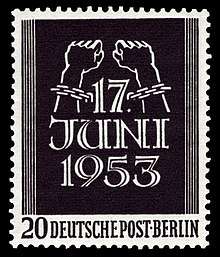East German uprising of 1953
The East German uprising of 1953 (German: Volksaufstand vom 17. Juni 1953 ) began with a strike action by East Berlin construction workers on 16 June, and turned into a widespread uprising against the communist German Democratic Republic government the next day. It involved more than one million people in about 700 localities.[1]
| East German uprising of 1953 | |||||||
|---|---|---|---|---|---|---|---|
| Part of the Cold War | |||||||
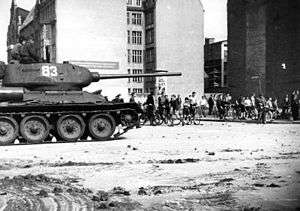 Soviet T-34-85 in East Berlin, 17 June | |||||||
| |||||||
| Belligerents | |||||||
|
| Demonstrators | ||||||
| Commanders and leaders | |||||||
| Unknown | |||||||
| Strength | |||||||
| 1,500,000 demonstrators | ||||||
| Casualties and losses | |||||||
| 5 police killed |
| ||||||
The uprising in East Berlin was violently suppressed by tanks of the Soviet occupation forces, and the Kasernierte Volkspolizei. In spite of the intervention of Soviet troops, the wave of strikes and protests were not easily brought under control. There were demonstrations in more than 500 towns and villages after 17 June.
The date, 17 June, was celebrated as a public holiday in West Germany up until the German reunification, after which it was replaced by German Unity Day, celebrated annually on 3 October. Strikes and working class networks, particularly relating to the old Social Democratic Party of Germany, anti-communist resistance networks and trade unions played a key role in the unfolding of the uprising.[2] The event was always significantly downplayed in the Soviet Union.
Background
In May 1952, the Federal Republic of Germany rejected Soviet leader Joseph Stalin’s second "Germany Note", after which the FRG signed up to the European Defence Community Treaty. Following these events, it became clear both to Moscow and Berlin that Germany would remain divided indefinitely. In Berlin, SED Party General Secretary Walter Ulbricht interpreted Stalin’s failed attempt at German reunification as a ‘green light’ to proceed with the “accelerated construction of socialism in the GDR,” which the party announced at its Second Party Conference in July 1952. This move to Sovietise the GDR consisted of a drastic increase in investment allocated to heavy industry, discriminatory taxation against the last private industrial enterprises, the forced collectivisation of agriculture and a concerted campaign against religious activity in East Germany.[3]
However, the result of this change in economic direction was the rapid deterioration of workers’ living standards, which lasted until the first half of 1953, and represented the first clear downward trend in the living standard of East Germans since the 1947 hunger crisis. Travel costs rose as generous state subsidies were cut, while many consumer goods began to disappear from store shelves. Factories were forced to clamp down on overtime: in the context of a now restricted budget, the wage bill was deemed excessively high.[4] Meanwhile, food prices rose as a result of both the effects of the state's collectivisation policy – 40% of the wealthier farmers in the GDR fled to the West, leaving over 750,000 hectares of otherwise productive land lying fallow – and a poor harvest in 1952.[5] Workers’ cost of living therefore rose, while the take-home pay of large numbers of workers – many of whom depended on overtime hours to make ends meet – was diminishing. In the winter of 1952–53, there were also serious interruptions to the supply of heat and electricity to East Germany's cities. By November 1952, sporadic food riots and incidents of industrial unrest took place in some of the GDR's major industrial centres: Leipzig, Dresden, Halle and Suhl. Industrial unrest continued throughout the following spring, which ranged from rabble-rousing and anti-SED graffiti to alleged sabotage.[6]
To ease the economic strain caused by the "construction of socialism," the Politburo decided to increase worker norms on a compulsory basis by 10% across all state-owned factories: that is, workers now had to produce 10% more for the same wage.[7] Additionally, there were increases in prices for food, health care, and public transportation. Taken together, the norm and price increases amounted to a 33 per cent monthly wage cut.[8] The norm increase would take effect on 30 June, Ulbricht's 60th birthday.
Ulbricht's response to the consequences of crash Sovietization was to tighten East Germans’ belts; many East Germans’ response was to leave. In 1951, 160,000 people left; in 1952, 182,000. In the first four months of 1953, a further 122,000 East Germans departed for the West, despite the now mostly sealed border.[9]
The new collective leadership in the Soviet Union, established following Stalin's death in March 1953, was shocked by these disconcerting statistics when it received in early April a report from the Soviet Control Commission in Germany which provided a detailed, devastating account of the East German economic situation.[10] By 2 June, the Soviet Union leadership issued an order “On Measures to Improve the Health of the Political Situation in the GDR,” in which the SED’s policy of accelerated construction of socialism was roundly criticised. The huge flight of all professions and backgrounds from East Germany to the West had created “a serious threat to the political stability of the German Democratic Republic.” To salvage the situation, it was now necessary to end forced collectivisation and the war on private enterprise. The Five-Year Plan now needed to be changed at the expense of heavy industry and in favour of consumer goods. Political-judicial controls and regimentation had to be relaxed, and coercive measures against the Protestant Church had to cease. Ulbricht's “cold exercise of power” was denounced. However, there was no explicit demand to reverse the unpopular raised work norms. This decree was given to SED leaders Walter Ulbricht and Otto Grotewohl on 2 June, the day they landed in the Soviet capital. Soviet Premier Georgy Malenkov warned them that changes were essential to avoid a catastrophe.[11]
On 9 June, the East German Politburo met and determined how to respond to the Soviet leadership's instructions. Although most Politburo members had concurred that the announcement of the “New Course” required careful preparation of the party and the population at large, Soviet High Commissioner for Germany Vladimir Semyonov insisted that it be implemented right away.[12] Thus, the SED fatefully published the “New Course” programme in Neues Deutschland, the official party newspaper of the SED, on 11 June. The communique criticised the mistakes made by the SED and announced that most of Ulbricht's Sovietisation campaign would now be reversed, just as had been instructed by Moscow. There was now going to be a shift towards investment in consumer goods; the pressures on small private enterprise would end; forced collectivisation would cease; and policies against religious activity would be discontinued. But, crucially, the norm increase was not revoked: a threat to the legitimacy of a state that claimed to represent its workers - the bourgeoisie and farmers stood to benefit much more from the New Course than the proletariat.
The communique and its forthright admission of past mistakes shocked and confused many East Germans – both SED members and the wider populace. Disappointment, disbelief and confusion pervaded local party organisations, whose members felt betrayed and panicky. The wider populace viewed the “New Course” as a sign of weakness on the part of the East German regime.[13]
The next day, 12 June, 5,000 people participated in a demonstration in front of the Brandenburg prison.[14] More confusion followed: on 14 June, an editorial in Neues Deutschland condemned the new work norms; yet in that very issue, in contradiction to the editorial, news articles praised workers who had exceeded the new norms.
On 15 June, workers at the Stalinallee “Block 40” site, Berlin, now with their hopes raised about the possibility that the work norms would be rescinded, dispatched a delegation to East German Prime Minister Otto Grotewohl to deliver a petition calling for a revocation of the higher work norms. Grotewohl ignored the workers’ demands.[15]
Uprising
16 June
| Eastern Bloc | |||||||
|---|---|---|---|---|---|---|---|
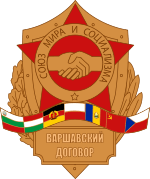 | |||||||
|
Allied states
|
|||||||
|
Related organizations |
|||||||
|
Dissent and opposition
|
|||||||
An article in the trade union paper, Tribune, restated the necessity of the norm increases. Evidently, the government would not retreat on the issue of the 10% norm increase.
So, at 9am on the morning of 16 June, 300 workers from the construction sites at “Hospital Friedrichshain” and “Stalinallee Block 40” went on strike and marched on the FDGB headquarters in the Wallstrasse and thence to the city centre, hoisting banners and demanding a reinstatement of the old norms. Demands broadened out to encompass political matters. Via Alexanderplatz and Unter den Linden, most of the demonstrators moved to the government seat on Leipziger Strasse; others went to the SED HQ on Wilhelm-Pieck-Strasse. En route, they took over two sound trucks and used them to spread their calls for a general strike and a demonstration, set for the Strausberger Platz at 7am the morrow. In front of the GDR House of Ministries, the quickly growing crowd demanded to speak to Ulbricht and Grotewohl. Only Heavy Industry Minister Fritz Selbmann and Professor Robert Havemann, president of the GDR Peace Council, emerged. Their attempts to calm the workers were drowned out by the clamour of the crowd, which shouted the pair down.[16]
Meanwhile, the Politburo deliberated, unable to decide what to do. Despite the urgency of the situation, it was only after hours of deliberation – under the pressure of the demonstrators, and probably also from Semyonov – that the leadership decided to revoke the norm increase. They decreed that increases in productivity would now be voluntary. They blamed the strikes and demonstrations partly on how the rise had been implemented, partly on foreign provocateurs. But by the time an SED functionary reached the House of Ministries to give the workers the news, the protestors’ agenda had expanded well beyond the issue of norm increases.[17] Later that afternoon the crowd dispersed, and workers returned to their sites. Save for isolated clashes between the People's Police and groups of demonstrators, there was a period of calm for the remainder of the day.
The SED leadership was surprised by the depth of resentment and the extent of anti-regime actions. Indeed, so out of touch were they that they expected a massive propaganda drive would be sufficient to cope with the emerging crisis. It would not be enough, and Ulbrich probably realised this only after a few hours after that suggestion was made.[18] The Soviet authorities were likewise completely taken aback by the widespread protests that followed the demonstrations in East Berlin. Their response was improvised and uncoordinated. Later that evening, Semyonov met with the SED leadership and informed them of his decision to send Soviet troops to Berlin.[19]
Throughout the night of 16 June and early morning of 17 June, the news of events in East Berlin spread quickly throughout the GDR: via word of mouth and by Western radio broadcasts, particularly RIAS. RIAS had been broadcasting about the strikes being staged against the increase in work norms throughout the day; in the afternoon, there were broadcasts of the change in the demonstrator's demands: from the repeal of the higher work quotas and price cuts to shouts of “We want free elections.” RIAS was later approached by East Berlin workers who sought assistance from them in disseminating their call for a general strike the next day. The station's political director, Gordon Ewing, decided that the station could not directly lend itself as a mouthpiece to the workers: in his view, this had the potential to start a war. It would not actively incite rebellion, either – simply broadcast information about the demonstrations, factually and comprehensively. Nonetheless, at 7.30pm RIAS reported that a delegation of construction workers had submitted a resolution for publication. The resolution stated that the strikers, having proved by their actions that “they were able to force the government to accept their justified demands,” would “make use of their power at any time” if their demands for lower quotas, price cuts, free elections and indemnity for all demonstrators were not fulfilled.
Later that night, there was all but active encouragement to demonstrate against the regime. RIAS Programme Director Eberhard Schutz called the regime's reversal on the norm question “a victory, which our Ostberliners share with the entire working population of the Soviet Zone.” He attributed the government's U-turn to the workers’ actions. His listeners’ demands – i.e., the resignation of the government, Western-style liberties, etc. – were justified, and encouraged them to support the demonstrators. Schutz said that RIAS and the East German people expect these demands to be met: it was the East German people's task to show the SED and the Soviet Communist Party that this was true.
Following West Germany's Federal Minister for All-German Questions Jakob Kaiser’s admonition in a late night broadcast to East Germans to shy away from provocations, RIAS, starting with its 11pm news broadcast, and from then on in hourly intermissions, repeated the workers’ demand to continue the strike the next day, calling specifically for all East Berliners to participate in a demo at 7am on the 17th at Strausberger Platz.[20]
17 June
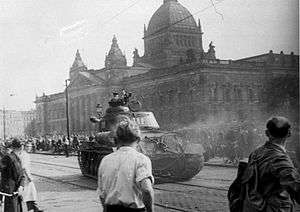
East Berlin
Following Semyonov's decision, Soviet troops entered the environs of East Berlin in the early morning of 17 June. Meanwhile, crowds of workers began to gather at Strausberger Platz and other public places and began towards the city centre. En route, they encountered GDR security forces – regular and Barracked People's Police units (KVP) – who, apparently lacking instructions, did not initially intervene.
Along with SED and FDJ functionaries, police officials tried – and mostly failed – to convince the marchers to return to their workplaces and homes. Where police attempted to halt or disperse the crowds, they rapidly ended up on the defensive.
As they drew in ever-greater numbers, a feeling of solidarity permeated the demonstrators. Loudspeaker cars and bicycles provided communications between the different columns of marchers from the outer districts as, all morning, they converged on the city centre.
On improvised banners and posters, the demonstrators again demanded the reinstatement of the old norms, but also price decreases, the release of fellow protestors who had been arrested the day before, even free and fair all-German elections. Slogans like “Down with the government!” and “Butter, not Arms” were also visible. Party posters and statues – especially those depicting SED and Soviet leaders – were ransacked, burned or otherwise defaced.
By 9am, 25,000 people were gathered in front of the House of Ministries, and tens of thousands more were en route to Leipziger Strasse or across Potsdamer Platz. Between 10am and 11am, 80 to 100 demonstrators seemed to storm the government seat, visibly demonstrating that the 500 members of GDR People's Police and State Security had been overpowered.[21]
Then, suddenly, Soviet military vehicles appeared, followed by tanks, and they appeared to prevent a complete takeover. Within an hour, Soviet troops had cleared and isolated the area around the government headquarters. At noon, the Soviet authorities terminated all tram and metro traffic into the Eastern sector and all but closed the sector borders to West Berlin to prevent more demonstrators from reaching the city centre. An hour later, they declared martial law in East Berlin.[22]
The repression took place outside East Berlin police HQ – where Soviet tanks opened fire on “the insurgents”. Fighting between the Red Army (and later GDR police) and the demonstrators persisted into the afternoon and night – with, in some cases, tanks and troops firing directly into the crowds. Executions (most prominently of West Berlin worker Willi Gottling) and mass arrests followed.
Overnight, the Soviets (and the Stasi) started to arrest hundreds of people. Ultimately, up to 10,000 people were detained and at least 32, probably as many as 40, people were executed, including Red Army soldiers who refused to obey orders[23]. With the SED leadership effectively paralysed at the Soviet headquarters in Karlshorst, control of East Berlin passed to the Soviets in East Berlin.[24]
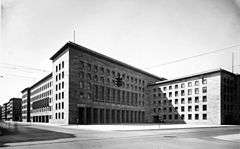
Outside of East Berlin
All of East Germany's 24 cities with a population larger than 50,000 experienced upheavals; likewise in the case of roughly 80% of its towns with populations above 10,000 but below 50,000. Approximately 339,000 participated in 129 demonstrations outside of Berlin; more than 225,000 people struck in 332 factories.
The main centres of activity included the industrial region around Halle, Merseburg, and Bitterfeld, as well as middle-size towns like Jena, Gorlitz, and Brandenburg. No more than 25,000 people participated in strikes and demonstrations Leipzig, but there were 32,000 in Magdeburg, 43,000 in Dresden, 53,000 in Potsdam – and in Halle, a figure close to 100,000.
At first, such demonstrations were relatively peaceful, but as increasing numbers began to participate, the protests became more violent. Looting, particularly of Party-owned shops, became a regular occurrence; there was some arson, and many Party functionaries were beaten up later in the day. In some towns, the jails were seized by the demonstrators, who demanded the release of certain political prisoners.[25] When the Red Army intervened in these places outside of Berlin, they seemed to be more restrained and more passive. Some Soviet soldiers even displayed a friendly attitude towards the demonstrators.[26]
In the countryside, meanwhile, protests took place in more than 200 villages. However, many East German farmers did not take collective action against the regime: the most common expression of protest in rural areas was for farmers to leave and/or dissolve recently formed collective farms and resume farming on one's own.[27]
Although the demands made by protesters could be political – in favour of the dissolution of the East German government and the organisation of free elections, e.g. – often they were simply of a local and economic character. They were about issues like bread shortages, unpopular night shifts, even the number of toilets in the workplace and the fact that tea was being served in rusty urns.[28]
Others, particularly workers, demanded the re-foundation of the SPD in East Germany. Among former Social Democrats there existed enormous bitterness against their ex-leader Otto Grotewohl, whom they believed had ‘betrayed the SPD.’ In their view, he should now ‘have his neck wrung.’[29] Also expressed were widely held grievances against the intelligentsia, who were perceived to enjoy ‘unfair privileges’, such as special deliveries of basic foodstuffs and other commodities.[30]
There were even Nazi elements involved in the protests, though seldom as ringleaders. Walls, bridges and school blackboards were defaced with Nazi slogans and swastikas. In some places, Nazi songs were sung on demonstrations. A significant minority of East Germans still clung to ideas of Nazism.[31]
Aftermath
Protests and demonstrations continued for days after 17 June and, according to the GDR security service, the situation calmed down only by 24 June.[32]
Many workers lost faith in East Germany's socialist state following the denouement of the uprising. Out of disgust at the violent suppression of the strikes – at the fact that the Volkspolizei had shot at workers: that workers had shot their own kind – the SED lost large numbers of members. Throughout the Bezirke of Leipzig and Karl-Marx-Stadt, hundreds of SED members, many of whom had spent decades in the labour movement, left the party. At the Textima plant in Altenberg, 450 SED members had left the party by 7 July – most of them workers, many of whom with great experience in the labour movement. There was also a widespread refusal of workers to pay their trade union subscriptions: they now ceased to support it, and hence also to confer legitimacy upon it.[33]
Ulbricht Survives
Meanwhile, Ulbricht's position as party leader became tenuous, and his position was only saved by the leadership turmoil in Moscow following the death of Joseph Stalin. Ulbricht, after all, was tainted by his association with the disastrous Second Party Conference, the policies following which had led to the crisis East Germany was now mired in.
By the time of a Politburo meeting on 8 July, it seemed that Ulbricht was approaching the end of his time as party leader. Minister of State Security Wilhelm Zaisser conceded that the whole Politburo was responsible for the ‘accelerated construction of socialism’ and the disastrous fallout thereof. But he also added that to leave Ulbricht as leader “would be opposed catastrophic for the New Course.” By the end of the meeting, just two Politburo members supported Ulbricht's continued leadership: Free German Youth League chief Erich Honecker and Party Control Commission Chairman Hermann Matern. Ulbricht only managed to forestall a decision then and there with a promise to make a statement at the forthcoming 15th SED CC Plenum, scheduled for later that month.[34]
The leading Soviet officials in East Berlin – Semyonov, Yudin and Sokolovskii – had reached the same conclusion in a report describing and analysing the events of 17-19 June, submitted to Moscow two weeks earlier, 24 June. In a self-serving report which sought to play down the culpability of the Soviet Commission in East Berlin and emphasise the responsibility of Ulbricht for the Uprising, they concluded – inter alia – that Ulbricht's position as general secretary should be terminated, and that the party would move towards collective leadership, in addition to other far-reaching structural political changes in East Berlin.[35]
However, the situation in Moscow dramatically changed just two days later, on 26 June, when Soviet Security Chief Lavrentiy Beria was arrested. On 2 July, when a commission met to discuss proposals for reform in East Germany, the decision was made to shelve the far-reaching and political sensitive changes. The Soviet leadership, preoccupied with the Beria affair and its internal implications, became disinclined to rock the East German boat and more inclined towards the maintenance of the status quo: to maintain power in East Germany via the reinforcement of an experienced, reliable, if Stalinist and unpopular, ruler.
In late July Ulbricht, ever more certain of his continued backing in Moscow, expelled his main opponents, Zaisser, Hernstadt and Ackermann, from the Politburo, and thus strengthened his position further.[36]
By late August, Moscow had committed to shoring up the current East German regime. Now, the situation in East Germany had stabilised thanks to economic measures implemented by Moscow and East Berlin. Major political changes in the GDR dropped off the agenda. Substantial economic and financial aid was to flow into East Germany and reparation payments were to cease by the end of the year. Additional prisoners of war would be freed and Moscow's mission in Berlin elevated to the status of embassy. Ulbricht's position was firmly secure once more.[37]
The Uprising's impact on the long-term development of the GDR
According to historian Corey Ross, the party leadership derived two key lessons from 17 June.
The first was that it became more concerned about shopfloor discontent and now sought more determinedly to preclude it from escalating into a broader conflict. Factory surveillance was now raised to better monitor the mood of the workforce, Kampfgruppen der Arbeiterklasse (workforce combat groups) were established as an on-the-spot force to prevent or quell any signs of unrest, and the Stasi was expanded and improved to deal swiftly with any signs of organised protest in the future.
The second was that it became clear that a heavy-handed venture such as the ‘accelerated construction of socialism’ could never again be embarked upon. SED General Secretary Walter Ulbricht was haunted throughout the 1950s by the thought of a repetition of 17 June. The government never again attempted to introduce arbitrary blanket norm increases such as it attempted in May and June 1953. The “New Course” policies – increased investment in consumer goods, housing and price and travel subventions – led to an improvement in living standards overall but failed to achieve an immediate end to the discontent that had been accumulating over the past year.
Workers, meanwhile, learnt that little could be gained from open confrontation – to act openly against the regime in large numbers was to be left to their own devices by the West against Soviet tanks.[38]
Legacy
In memory of the 1953 East German rebellion, West Germany established 17 June as a national holiday, called Day of German Unity. Upon German reunification in October 1990, it was moved to 3 October, the date of formal reunification. The extension of the Unter den Linden boulevard to the west of the Brandenburg Gate, called Charlottenburger Chaussee, was renamed Straße des 17. Juni ("17 June Street") following the 1953 rebellion.
The event is commemorated in "Die Lösung", a poem by Bertolt Brecht. Other prominent GDR authors who dealt with the uprising include Stefan Heym (Fünf Tage im Juni / "Five Days in June", Munich 1974) and Heiner Müller (Wolokolamsker Chaussee III: Das Duell / "Volokolamsk Highway III: The Duel", 1985/86).
West German group Alphaville mention the date explicitly as "the seventeenth of June" but without reference to the year in their 1984 song "Summer in Berlin," from the album Forever Young. When the compilation album Alphaville Amiga Compilation was assembled for release in East Germany in 1988, the song "Summer in Berlin" was submitted for inclusion, but rejected "for political reasons."[39]
The 1966 Günter Grass play The Plebeians Rehearse the Uprising depicts Brecht preparing a production of Shakespeare's Coriolanus against the background of the events of 1953.[40]
See also
- Poznań protests, June 1956
- Hungarian Revolution, October–November 1956
- Warsaw Pact invasion of Czechoslovakia, August 1968
- Tiananmen Square protests, April–June 1989
- Monday demonstrations in East Germany, September 1989 – April 1991
Notes
- Alison Smale (17 June 2013). "60 Years Later, Germany Recalls Its Anti-Soviet Revolt". The New York Times. Retrieved 18 June 2013.
- Dale, Gareth. "East German rising 17 June 1953". academia.edu. Jacobin Magazine. Retrieved 18 June 2017.
- Kopstein, 411
- Ross, 54
- Ibid.; Kopstein, 411
- Ross, 54
- Hutchinson, 368
- Ross, 55
- Ostermann, 3
- Richter, 677
- Ostermann, 18
- Ostermann, 20
- Ostermann, 20
- Ostermann, 163
- Ostermann, 163
- Ostermann, 162
- Ostermann, 165
- Ostermann, 166
- Ostermann, 169
- Ostermann, 163
- Ostermann, 164
- Ostermann, 164
- "Of Flowers and Murder". Discover Magazine. Retrieved 18 June 2020. https://www.discovermagazine.com/planet-earth/of-flowers-and-murder
- Ostermann, 169
- Hutchinson, 369
- Ostermann, 169
- Port, 124
- Pritchard, 211
- Pritchard, 212
- Ross, 56
- Pritchard, 209
- Ostermann, 170
- Pritchard, 214
- Ostermann, 168
- Ostermann, 170-171
- Ostermann, 179
- Ostermann, 180
- Ross, 57-59
- Alphaville Discography
- Clive Barnes (23 July 1970). "Stage: Grass on Brecht". The New York Times. Retrieved 2 May 2020.
Bibliography
- Baring, Arnulf. Uprising in East Germany: June 17, 1953 (Cornell University Press, 1972)
- Harman, Chris, Class Struggles in Eastern Europe, 1945–1983 (London, 1988) ISBN 0-906224-47-0
- Millington, Richard (2014). State, Society and Memories of the Uprising of 17 June 1953 in the GDR. Palgrave Macmillan.
- Ostermann, Christian F.; Malcolm Byrne. Uprising in East Germany, 1953. Central European University Press.
- Ostermann, Christian F. "" Keeping the Pot Simmering": The United States and the East German Uprising of 1953." German Studies Review (1996): 61–89. in JSTOR
- Ostermann, Christian F. The United States, the East German Uprising of 1953, and the Limits of Rollback (Working Paper #11. Cold War International History Project, Woodrow Wilson International Center for Scholars, 1994) online
- Richie, Alexandra. Faust's Metropolis: a History of Berlin. New York: Carroll & Graf Publishers, 1998, ch 14
- Sperber, Jonathan. "17 June 1953: Revisiting a German Revolution" German History (2004) 22#4 pp. 619–643.
- Tusa, Ann . The Last Division: a History of Berlin, 1945-1989. Reading, Massachusetts: Addison-Wesley, 1997.
- Watry, David M. Diplomacy at the Brink: Eisenhower, Churchill, and Eden in the Cold War. Baton Rouge: Louisiana State University Press, 2014.
- Ilko-Sascha Kowalczuk: 17. Juni 1953. Geschichte eines Aufstands. Beck, München 2013.
- Ross, Corey, Constructing Socialism at the Grass-Roots: The Transformation of East Germany, 1945–65, London: Macmillan, 2000.
- Kopstein, Jeffrey, "Chipping Away at the State: Workers' Resistance and the Demise of East Germany", World Politics 48 (April 1996), 391-42
- Pritchard, Gareth, The Making of the GDR: From antifascism to Stalinism, Manchester: Manchester University Press, 2000
- Richter, James, "Re-Examining Soviet Policy towards Germany in 1953", Europe-Asia Studies, Vol. 45, No. 4 (1993), pp. 671-691
- Hutchinson, Peter, "History and Political Literature: The Interpretation of the "Day of German Unity" in the Literature of East and West", The Modern Language Review, Vol. 76, No. 2 (Apr., 1981), pp. 367-382
- Port, Andrew, "East German Workers and the “Dark Side”of Eigensinn: Divisive Shop-Floor Practices and the Failed Revolution of June 17, 1953" in Falling Behind or Catching Up? The East German Economy, 1945–2010, ed. Hartmut Berghoff and Uta Balbier, Cambridge: Cambridge University Press, 2013.
External links

- A film clip of the sixth anniversary of 1953 East Berlin uprising (1959) is available at the Internet Archive
